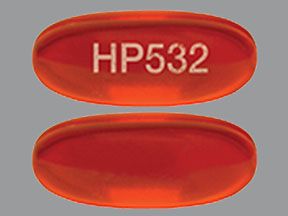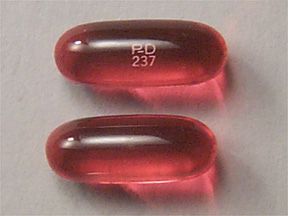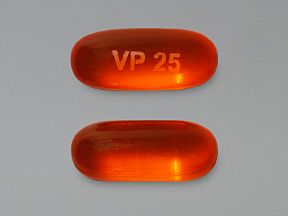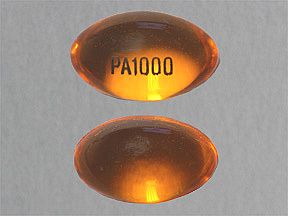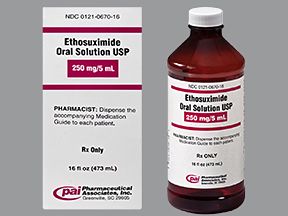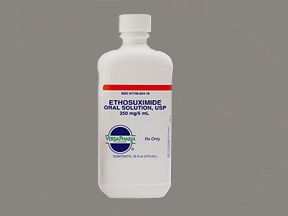Highlights for ethosuximide
- Ethosuximide oral capsule is available as a brand-name drug and a generic drug. Brand name: Zarontin.
- Ethosuximide comes as a capsule or a solution you take by mouth.
- Ethosuximide oral capsule is used to treat absence (petit mal) seizures in people with epilepsy.
- Blood cell defects warning: Ethosuximide can cause abnormal amounts of blood cells and platelets. This can be fatal.
- Liver and kidney problems warning: This drug can harm your liver and kidneys. If you have liver or kidney disease, you should use this drug with caution.
- Suicidal thoughts warning: Drugs used to treat epilepsy can increase your risk of suicidal thoughts and actions. Call your doctor if you have any unusual changes in your mood or behavior, or if you have thoughts of hurting yourself.
- Multiorgan hypersensitivity warning: Ethosuximide can cause a severe allergic reaction. This is called drug reaction with eosinophilia and systemic symptoms (DRESS). This reaction can occur at any time (as soon as two to six weeks after starting this drug) and may be fatal. Symptoms may include:
- skin rash
- fever
- swollen lymph glands
- organ damage, including liver failure
- yellowing of your skin or the whites of your eyes
- swelling in the upper right section of your stomach
- change in how much you urinate
- trouble breathing
- chest pain
Ethosuximide is a prescription drug. It comes as an oral capsule or an oral solution.
Ethosuximide oral capsule is available as the brand-name drug Zarontin. It’s also available in a generic form. Generic drugs usually cost less than the brand-name version. In some cases, they may not be available in every strength or form as the brand-name drug.
Ethosuximide may be taken as part of a combination therapy with other anti-seizure drugs.
Why it’s used
Ethosuximide oral capsule is used to reduce or stop absence seizures (petit mal seizures) in people with epilepsy.
How it works
Ethosuximide belongs to a class of drugs called antiepileptic drugs (AEDs). A class of drugs is a group of medications that work in a similar way. These drugs are often used to treat similar conditions.
Ethosuximide works by reducing the number of seizures that cause you to lose consciousness. It does this by preventing your brain from reacting to things that can cause you to have a seizure.
Ethosuximide oral capsule may cause drowsiness. Don’t operate a vehicle, use machinery, or do similar activities that require alertness until you know how this drug affects you.
This drug can also cause other side effects.
More common side effects
The more common side effects that can occur with ethosuximide include:
- Stomach problems, such as:
- nausea
- vomiting
- diarrhea
- stomach pain
- indigestion
- loss of appetite
- Weight loss
- Tiredness or fatigue
- Dizziness or lightheadedness
- Unsteadiness when walking
- Headache
- Trouble concentrating
- Hiccups
If these effects are mild, they may go away within a few days or a couple of weeks. If they’re more severe or don’t go away, talk to your doctor or pharmacist.
Serious side effects
Call your doctor right away if you have serious side effects. Call 911 if your symptoms feel life-threatening or if you think you’re having a medical emergency. Serious side effects and their symptoms can include the following:
- Serious allergic reactions, including Stevens-Johnson syndrome, which can be a life-threatening allergic skin reaction. Symptoms can include:
- skin rash
- hives
- sores in your mouth, nose, or around your eyes
- blistering or peeling skin
- trouble breathing
- swelling of your lips, tongue, or face
- Changes in thinking, mood, or behavior, such as:
- suspicious thoughts
- hallucinations (seeing or hearing things that aren’t there)
- delusions (having false thoughts or beliefs)
- More frequent or worse grand mal seizures
- Life-threatening blood problems. Symptoms can include:
- fever, swollen glands, or a sore throat that comes and goes, or doesn’t go away
- frequent infections or an infection that doesn’t go away
- bruising more easily than normal
- red or purple spots on your body
- nosebleeds, or bleeding from your gums
- severe fatigue or weakness
- Systemic lupus erythematosus, an autoimmune disease, while you’re taking the drug. Symptoms can include:
- joint pain and swelling
- muscle pain
- fatigue
- low-grade fever
- pain in your chest that gets worse with breathing
- unexplained skin rash
- Suicidal thoughts or actions. Symptoms can include:
- thoughts about suicide or dying
- attempts to commit suicide
- new or worsened depression or anxiety
- panic attacks
- trouble sleeping
- new or worsened irritability
- acting aggressive or violent or being angry
- acting on dangerous impulses
- an extreme increase in activity and talking (mania)
Disclaimer: Our goal is to provide you with the most relevant and current information. However, because drugs affect each person differently, we cannot guarantee that this information includes all possible side effects. This information is not a substitute for medical advice. Always discuss possible side effects with a healthcare provider who knows your medical history.
Ethosuximide oral capsule can interact with other medications, vitamins, or herbs you may be taking. An interaction is when a substance changes the way a drug works. This can be harmful or prevent the drug from working well.
To help avoid interactions, your doctor should manage all of your medications carefully. Be sure to tell your doctor about all medications, vitamins, or herbs you’re taking. To find out how this drug might interact with something else you’re taking, talk to your doctor or pharmacist.
Examples of drugs that can cause interactions with ethosuximide are listed below.
Phenytoin
Taking this drug with ethosuximide can cause the levels of this drug to increase in your body, which may put you at increased risk for side effects. Your doctor should check your blood levels regularly if you take these medications together.
Valproic acid
Taking this drug with ethosuximide can increase or decrease the levels of ethosuximide in your body. Your doctor should check your blood levels regularly if you take these medications together.
Disclaimer: Our goal is to provide you with the most relevant and current information. However, because drugs interact differently in each person, we cannot guarantee that this information includes all possible interactions. This information is not a substitute for medical advice. Always speak with your healthcare provider about possible interactions with all prescription drugs, vitamins, herbs and supplements, and over-the-counter drugs that you’re taking.
This drug comes with several warnings.
Allergy warning
Ethosuximide can cause a severe allergic reaction, which may be fatal. Symptoms of an allergic reaction include:
- rash
- hives
- peeling or blistering skin
- sores in your mouth, nose, or around your eyes
- trouble breathing
- swelling of your tongue, lips, or face
If you develop these symptoms, call 911 or go to the nearest emergency room.
Don’t take this drug again if you’ve ever had an allergic reaction to it. Taking it again could be fatal (cause death).
Alcohol interaction warning
You shouldn’t drink alcohol while you’re taking ethosuximide. Combining this drug with alcohol can increase your chance of sleepiness or dizziness.
Warnings for people with certain health conditions
For people with liver disease: Ethosuximide can harm your liver. Use it with caution if you have liver disease.
For people with kidney disease: Ethosuximide can harm your kidneys. Use it with caution if you have kidney disease.
For people with grand mal seizures: Ethosuximide may increase the frequency of grand mal seizures in some people.
Warnings for other groups
For pregnant women: Ethosuximide may cause birth defects if you take it during pregnancy. Talk to your doctor if you’re pregnant or planning to become pregnant. This drug should only be used if the potential benefit justifies the potential risk to the pregnancy.
That said, drugs that treat seizures should generally not be stopped during pregnancy. If you stop taking the medication and have a seizure, you and your baby could have serious complications. Talk to your doctor about the best way to manage your seizures during pregnancy.
If you become pregnant while taking ethosuximide, you should enroll in the North American Antiepileptic Drug (NAAED) Pregnancy Registry. This group collects information about the safety of drugs that treat seizures during pregnancy. You can enroll by calling 1-888-233-2334.
For women who are breastfeeding: Ethosuximide passes through breast milk. It may cause serious effects in a child who is breastfed. Talk to your doctor if you’re currently taking ethosuximide and are considering breastfeeding.
For children: The safety and effectiveness of ethosuximide in people younger than 3 years haven’t been established.
When to call the doctorCall your doctor if the number of seizures you have increases or if you start having a different type of seizure.
All possible dosages and forms may not be included here. Your dose, form, and how often you take it will depend on:
- your age
- the condition being treated
- the severity of your condition
- other medical conditions you have
- how you react to the first dose
Dosage for epileptic absence seizures
Generic: Ethosuximide
- Form: oral capsule
- Strengths: 250 mg
Brand: Zarontin
- Form: oral capsule
- Strengths: 250 mg
Adult dosage (ages 18 years and older)
- Typical starting dosage: 500 mg per day taken by mouth. Your doctor may increase your total daily dosage by 250 mg every four to seven days until your seizures are controlled.
- Maximum recommended dosage: 1.5 g per day (taken in divided doses). If your doctor chooses to go higher than this, you’ll need extra monitoring.
Child dosage (ages 6 to 17 years)
- Typical starting dosage: 500 mg per day taken by mouth. Your doctor may increase your child’s total daily dosage by 250 mg every four to seven days until their seizures are controlled. The best dosage for most children is 20 mg/kg per day.
- Maximum recommended dosage: 1.5 g per day (taken in divided doses). If your doctor chooses to go higher than this, your child will need extra monitoring.
Child dosage (ages 3 to 6 years)
- Typical starting dosage: 250 mg taken by mouth once per day. Your doctor may increase your child’s total daily dosage by 250 mg every four to seven days until their seizures are controlled. The best dosage for most children is 20 mg/kg per day.
- Maximum recommended dosage: 1.5 g per day (taken in divided doses). If your doctor chooses to go higher than this, your child will need extra monitoring.
Child dosage (ages 0 to 2 years)
The safety and effectiveness of ethosuximide in people younger than 3 years haven’t been established.
Special dosage considerations
- For people with liver disease: Ethosuximide should be used with great caution if you have liver disease. Your doctor will periodically monitor your liver function.
- For people with kidney disease: Ethosuximide should be used with great caution if you have kidney disease. Your doctor will periodically monitor your kidney function.
- For children: Children may tolerate the liquid form of this drug better than the oral capsule.
Disclaimer: Our goal is to provide you with the most relevant and current information. However, because drugs affect each person differently, we cannot guarantee that this list includes all possible dosages. This information is not a substitute for medical advice. Always speak with your doctor or pharmacist about dosages that are right for you.
Ethosuximide oral capsule is used long-term to manage seizure disorder. It comes with serious risks if you don’t take it as prescribed.
If you don’t take it at all: Your seizure condition won’t improve and may get worse.
If you don’t take it on schedule: The drug may not be as effective. Stopping an anti-seizure medication suddenly can cause status epilepticus (seizures that won’t stop). This condition can be fatal. Don’t stop taking this drug without talking to your doctor first.
If you take too much: Taking too much ethosuximide can cause severe side effects, such as:
- nausea
- vomiting
- shallow or slowed breathing
- drowsiness
- coma
If you think you’ve taken too much of this drug, call your doctor or seek guidance from the American Association of Poison Control Centers at 1-800-222-1222 or through their online tool. But if your symptoms are severe, call 911 or go to the nearest emergency room right away.
What to do if you miss a dose: Take the dose as soon as possible. If it’s almost time for your next dose, skip the missed dose and go back to your normal schedule.
Don’t take two doses at the same time to make up for the missed dose. This could cause dangerous side effects.
How to tell if the drug is working: Your seizures should be better controlled.
Keep these considerations in mind if your doctor prescribes ethosuximide for you.
General
- Take ethosuximide at the same time each day.
- Don’t crush or cut the capsule.
Storage
- Store ethosuximide at room temperature of 77°F (25°C).
- Don’t freeze ethosuximide.
- Keep this drug in its original container.
- Keep this drug away from light.
- Don’t store this medication in moist or damp areas, such as bathrooms.
Refills
A prescription for this medication is refillable. You should not need a new prescription for this medication to be refilled. Your doctor will write the number of refills authorized on your prescription.
Travel
When traveling with your medication:
- Always carry your medication with you. When flying, never put it into a checked bag. Keep it in your carry-on bag.
- Don’t worry about airport X-ray machines. They can’t harm your medication.
- You may need to show airport staff the pharmacy label for your medication. Always carry the original prescription-labeled container with you.
- Don’t put this medication in your car’s glove compartment or leave it in the car. Be sure to avoid doing this when the weather is very hot or very cold.
Clinical monitoring
Before starting and during treatment with ethosuximide, your doctor may do tests to check your:
- liver function
- kidney function
- blood counts
- blood concentrations of ethosuximide
Prior authorization
Many insurance companies require a prior authorization for the brand-name version of this drug. This means your doctor will need to get approval from your insurance company before your insurance company will pay for the prescription.
There are other drugs available to treat your condition. Some may be better suited for you than others. Talk to your doctor about other drug options that may work for you.
Disclaimer: Healthline has made every effort to make certain that all information is factually correct, comprehensive, and up-to-date. However, this article should not be used as a substitute for the knowledge and expertise of a licensed healthcare professional. You should always consult your doctor or other healthcare professional before taking any medication. The drug information contained herein is subject to change and is not intended to cover all possible uses, directions, precautions, warnings, drug interactions, allergic reactions, or adverse effects. The absence of warnings or other information for a given drug does not indicate that the drug or drug combination is safe, effective, or appropriate for all patients or all specific uses.

